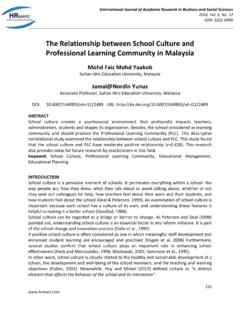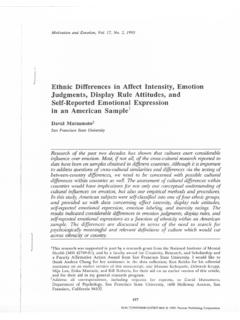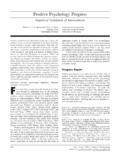Transcription of Eating Disorder Inventory-3 (EDI-3) Scale Descriptions ...
1 Eating Disorder Inventory-3 (EDI-3) Scale Descriptions David M. Garner, Psychological Assessment Resources (PAR)1. The EDI-3 consists of 91 items organized onto 12 primary scales, consisting of 3 Eating - Disorder - specific scales and 9 general psychological scales that are highly relevant to, but not specific to, Eating disorders . It also yields six composites: one that is Eating - Disorder specific ( , Eating Disorder Risk) and five that are general integrative psychological constructs ( , Ineffectiveness, Interpersonal Problems, Affective Problems, Overcontrol, General Psychological Maladjustment). Eating Disorder Inventory-3 Scale Descriptions Eating Disorder Inventory-3 Scale Descriptions Eating Disorder Specific Scales Drive For Thinness The "Drive for Thinness" construct has been described as one of the cardinal (DT) features of Eating disorders and has been considered an essential criterion for a diagnosis according to many classification schemes.
2 The 7 items on this Scale assess an extreme desire to be thinner, concern with dieting, preoccupation with weight and an intense fear of weight gain. Prospective studies have indicated that the DT Scale is a good predictor of binge- Eating and the development of formal Eating disorders Bulimia The Bulimia construct assesses the tendency to think about and to engage in (B) bouts of uncontrollable overeating (binge- Eating ). The 8 items on this Scale assess concerns about overeating and Eating in response to being upset. The presence of binge Eating is one of the defining features of bulimia nervosa and differentiates the bingeing/purging and restrictor subtypes of anorexia nervosa. Research has shown that binge Eating is common in individuals who do not meet all of the criteria to qualify for a formal diagnosis of an Eating Disorder ; however, in most cases, severe binge Eating is associated with marked psychological distress.
3 Body Dissatisfaction (BD) The Body Dissatisfaction Scale consists of 10 items that assess discontentment with the overall shape and with the size of those regions of the body of extraordinary concern to those with Eating disorders ( , stomach, hips, thighs, buttocks). One item on BD Scale measures the feeling of bloating after Eating a normal meal, a common feature of those who are dissatisfied with their body weight. Given the fact that body dissatisfaction is endemic to young women in Western culture, it is does not cause Disorder alone;. however, it may considered a major risk factor responsible for initiating and then sustaining extreme weight controlling behaviors seen in Eating disorders . Psychological Trait Scales Low Self-Esteem The Low Self-Esteem (LSE) construct measures the basic concept of negative (LSE) self-evaluation.
4 The LSE Scale targets affect-laden self-schemas with 5 of the 6 items assessing feelings of insecurity, inadequacy, ineffectiveness, and lack of personal worth. Additional content measures self-perception of being unable to achieve personal standards. Most theories consider low self-esteem to play a major role in the development and maintenance of Eating disorders . Personal Alienation The Personal Alienation (PA) construct is conceptually related to low self- (PA) esteem; however, goes further to reflect a pervasive sense of emotional emptiness, aloneness and poor sense of self-understanding. The 7 PA items include content reflecting feelings of being separated from, losing out or not being given due credit from others. PA items also measure the wish to be someone else and a general sense of being out of control of things in one's 1.
5 PAR owns the copyright for the EDI (EDI, EDI-2, EDI-3, EDI-RF) and the manuals, tests and scoring sheets can be ordered from PAR at The EDI is strictly protected under copyright laws. life. Interpersonal Insecurity The Interpersonal Insecurity (II) Scale consists of 7 items assessing discomfort (II) apprehension, and reticence in social situations. The II Scale focuses particularly on difficulties expressing personal thoughts and feelings with others. Item content on the II Scale also assess the tendency to withdrawal and isolate from others. Interpersonal Alienation The Interpersonal Alienation (IA) Scale includes 7 items that evaluate (IA) disappointment, distance, estrangement, and lack of trust in relationships. Item content also measures the tendency to feel trapped in relationships as well as the sense that there is a lack of understanding and love from others.
6 A. high score on the IA Scale indicates a basic impairment of attachment in relationships. Interoceptive Deficits The Interoceptive Deficits (ID) Scale consists of 9 items that measure (ID) confusion related to accurately recognizing and responding to emotional states. There is a fear of affect item cluster indicating distress when emotions are too strong or out of control that contrasts with an affective confusion item cluster indicating difficulty in accurately recognize emotional states. Confusion and mistrust related to affective and bodily functioning have been repeatedly described as an important characteristic of those who develop Eating disorders . Emotional Disregulation The Impulse Disregulation (ID) Scale consists of 8 items assessing a tendency (ED) toward mood instability, impulsivity, recklessness, anger, and self- destructiveness.
7 There are 2 items indicating potential problems with substance abuse; one for alcohol and one for drugs. The tendency toward poor impulse regulation and mood intolerance has been identified as a poor prognostic signs in Eating disorders . Items on the Impulse Disregulation Scale overlap with the "borderline" attributes characteristic of a subgroup of Eating Disorder patients considered particularly resistant to treatment. Perfectionism The Perfectionism (P) Scale consists of 6 items evaluating the extent to which (P) a person places a premium on achieving a high goals and standard of personal achievement. Item content on the Perfectionism Scale falls into two clusters: 3 items measure personal perfectionistic standards reflecting demanding personal standards for performance and 3 items assessing parental perfectionistic standards indicating pressures from parents and teachers.
8 Research has shown that perfectionism may be at the heart of relentless efforts at weight control as well as unrealistic strivings in other areas. It has been identified as a key feature in the development and maintenance of Eating disorders . Ascetism The Asceticism (A) Scale consists of 7 items assessing the tendency to seek (A) virtue through the pursuit of spiritual ideals such as self-discipline, self-denial, self-restraint, self-sacrifice and control of bodily urges. A 3-item suffering . cluster relates to the concept that self-denial makes a person stronger; a weakness cluster measures the tendency to view pleasure, relaxing and human weakness as shameful. The ascetic motive for weight loss was common in early writings on anorexia nervosa and is still an important theme in some cases.
9 Maturity Fears The Maturity Fears (MF) Scale consists of 8 items assessing the desire to (MF) retreat to the security of childhood. This construct has been described as a central maintaining feature in a subgroup of adolescent patients whose dieting and weight loss is functional in that it provides a means to return to a produces a pre-pubertal appearance and hormonal status that allows them to retreat from turmoil, conflicts and developmental expectations associated with adulthood. The fears of development may stimulate fears and expectations related to role-changes for which the adolescent, the parents or both feel ill prepared. Two items on this Scale as the respondent retrospectively on childhood; therefore, these items are not suited to younger children who are still in childhood.
10 Composite Scales Eating Concerns Composite The Eating Concerns Composite (ECC) is comprised of the summed T-scores (ECC) on the DT, B and BD scales. It provides a global measure of Eating concerns with equal weighting for each of the contributing scales. The ECC can be used for screening purposes or to obtain one score reflecting level of Eating concerns. Ineffectiveness Composite The Ineffectiveness Composite (IC) consists of the summed T-scores for the (IC) Low Self-Esteem (LSE) Scale and the Personal Alienation (PA) scales. These scales are highly correlated (.80 or above) for both clinical and non-clinical samples and their combination generally improves reliability (alpha). The IC. includes all of the items from the original EDI-2 Ineffectiveness Scale and adds three highly correlated items from the EDI-2 Social Insecurity Scale .





